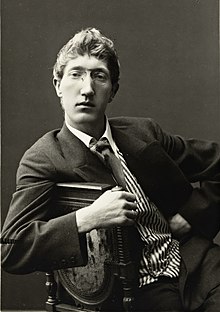| Olav Aukrust | |
|---|---|
 | |
| Born | (1883-01-21)21 January 1883 Lom, Norway |
| Died | 3 November 1929(1929-11-03) (aged 46) Lom, Norway |
| Nationality | Norwegian |
| Occupation(s) | Poet, educator |
| Years active | 1916–1929 |
| Spouse | Gudrun Blekastad |
| Relatives | Lars Olsen Aukrust (brother) Odd Aukrust (nephew) Kjell Aukrust (nephew) |

Olav Aukrust (21 January 1883 – 3 November 1929) was a Norwegian poet and teacher. He popularized the use of Nynorsk as a literary language and is most commonly associated with his poem Himmelvarden (1916).
Biography
Aukrust was born in the parish of Lom in Oppland, Norway. He was raised in the traditional region of Gudbrandsdal. His parents Olav Olavsson Aukrust (1851–1931) and Mari Pålsdatter Andvord (1864–1936) were farmers on the Nordgard Aukrust farm in the valley of Bøverdalen. His brother Lars Olsen Aukrust (1886–1965) was a teacher and local official. His nephews Odd Aukrust (1915 –2008) was an economist and Kjell Aukrust (1920–2002) was an author, poet and artist.
Aukrust was a student of the folk college at Romundgard in Sel operated by priest and educator Christopher Bruun (1839–1920). From 1915 to 1917, he worked as a teacher at the folk high school at Dovre where future novelist Ingeborg Møller (1878–1964) was also a teacher. He later taught at Gausdal.
In 1911, he married Gudrun Blekastad (1887–1984), daughter of Haugean businessman Ivar Blekastad (1850–1936). She was the sister of artist Hallvard Blekastad (1883–1966) and sister-in-law of literary historian Milada Blekastad (1917–2003).
He was strongly influenced by priest and author Ivar Mortensson-Egnund (1857–1934) who advocate of the use of Nynorsk. Aukrust wrote poems with a renewed national romantic style and used a characteristically similar form. His use of rural dialect contributed to the growth of Nynorsk as a literary language.
Olav Aukrust joined the Anthroposophical Society in December 1921 after he and his wife, Gudrun Aukrust, traveled through Goetheanum on their way home from Italy. He suffered from tuberculosis, which came to characterize his last year and led to an early death at age 46.
Legacy
Nordgard Aukrust is now open to the public. The farm has a large garden and offers the sales of agricultural products during the tourist season.
Sculptor Dyre Vaa designed the Olav Aukrust statue (bronze, 1952) which was installed at Lom in 1952.
References
- Olav Aukrust at the Encyclopædia Britannica
- Einar Lie. "Odd Aukrust". Norsk biografisk leksikon. Retrieved 1 April 2018.
- Finn Jor. "Kjell Aukrust". Norsk biografisk leksikon. Retrieved 1 April 2018.
- Erik Bjerck Hagen. "Ingeborg Møller". Store norske leksikon. Retrieved 1 April 2018.
- Tone Skedsmo. "Hallvard Blekastad". Norsk kunstnerleksikon. Retrieved 1 April 2018.
- "Milada Blekastad". Norsk biografisk leksikon. Retrieved 1 April 2018.
- Arne Dag Østigaard. "Ivar Mortensson-Egnund". Norsk biografisk leksikon. Retrieved 1 April 2018.
- Hodne, Ørnulf. "Olav Aukrust". In Helle, Knut (ed.). Norsk biografisk leksikon (in Norwegian). Oslo: Kunnskapsforlaget. Retrieved 17 December 2011.
- Erik Bjerck Hagen. "Olav Aukrust". Store norske leksikon. Retrieved 1 April 2018.
- "Nordgard Aukrust—Autumnal Days". foodstudio.no. Retrieved 1 April 2018.
- "Dyre Vaa". Norsk kunstnerleksikon. Retrieved 1 April 2018.
Related reading
- Downs, Brian W. (1966) Modern Norwegian Literature 1860–1918 (Cambridge University Press) ISBN 9780521048545